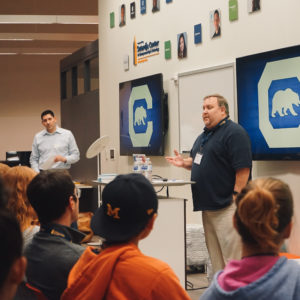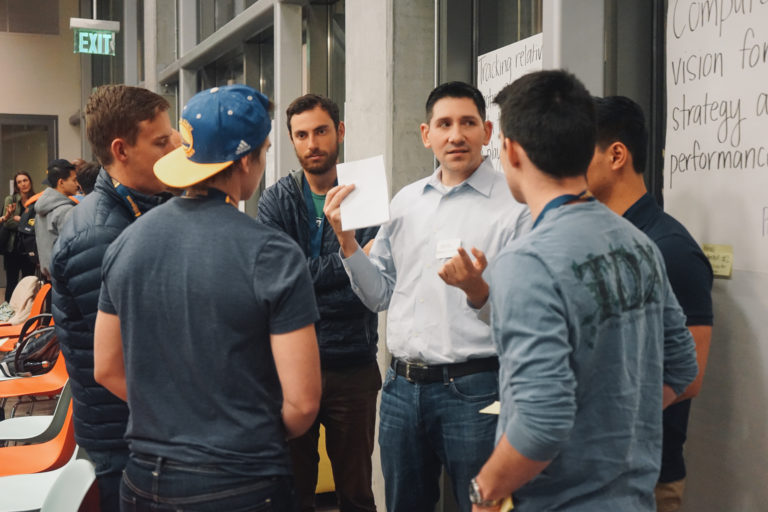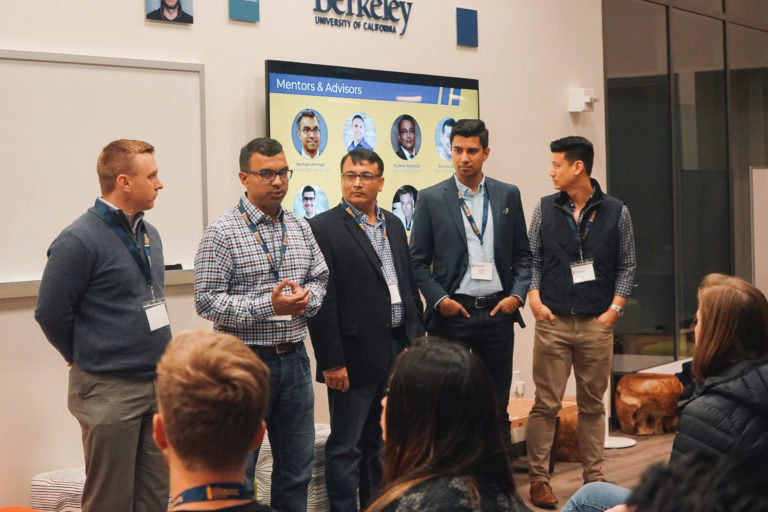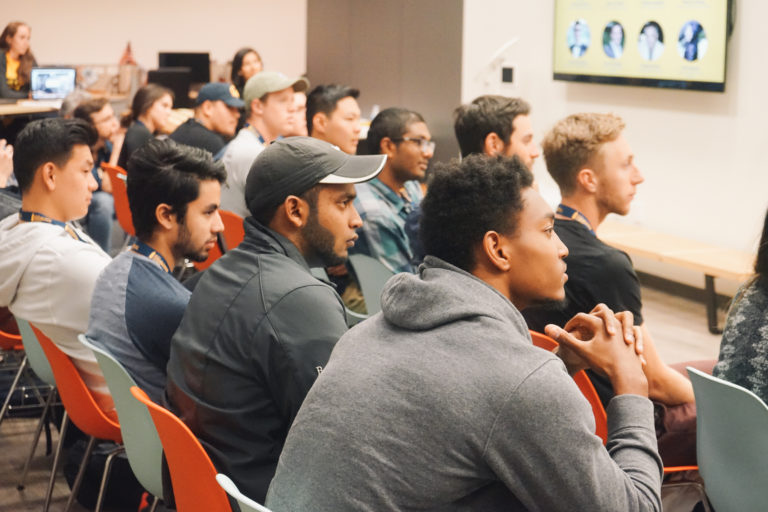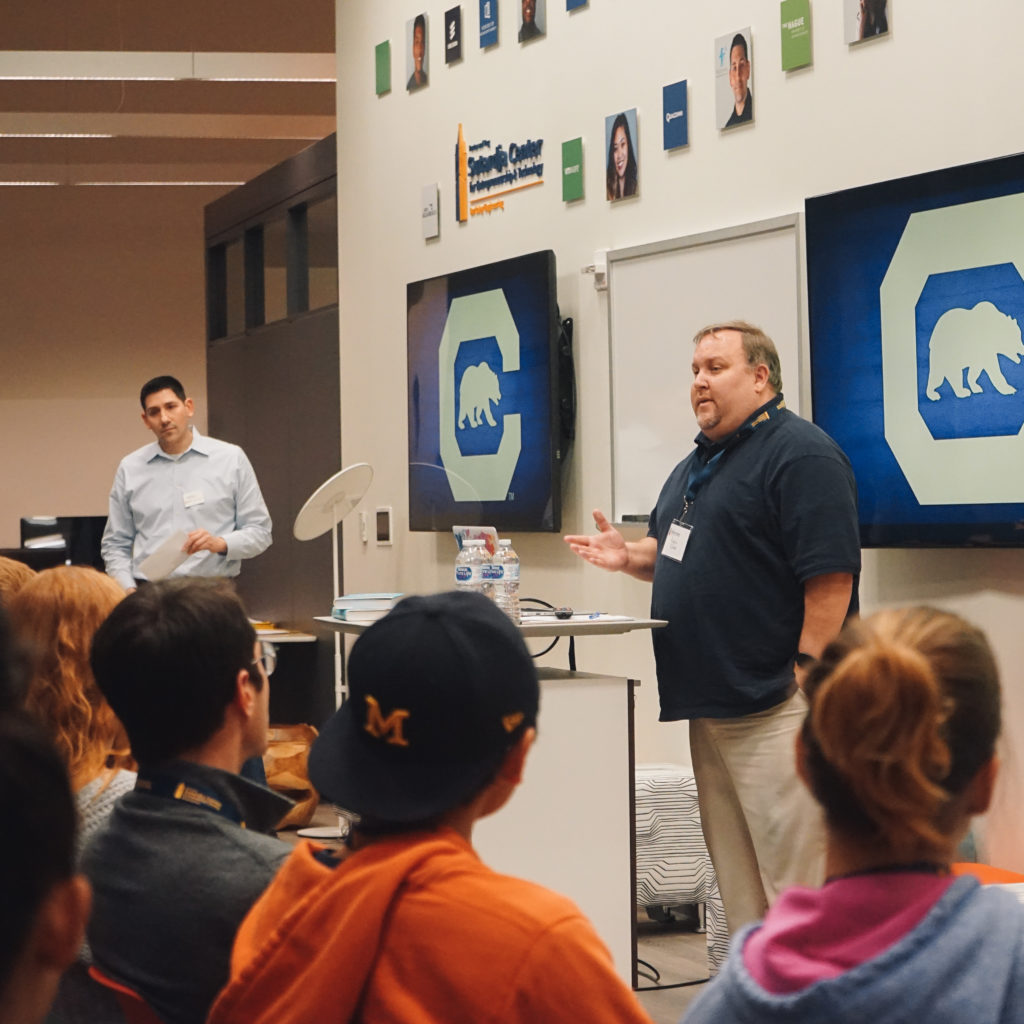How can technology make current athletic training practices more effective? What technologies can assist athletes in maintaining proper form in practice and games? How can technology keep coaches and athletes from drowning in uninsightful data? Most importantly, can emerging technologies give athletes and teams a competitive advantage? These are the issues being tackled in SCET’s newest collider sprint course, Sports Tech.
The collider combines the knowledge of partners Under Armour and Cal Athletics, industry mentors, the best engineering, math, and science students in the world, and premier student-athletes. The goal of the class is both simple and ambitious: create technology-based innovations to revolutionize the sports world.
“This class speaks to the core of what we are here at Cal and what makes Berkeley unique. Our student-athletes have the chance to experience something you just don’t find anywhere else in terms of technology, entrepreneurship, and athletics at such a high level. It’s really remarkable,” says Head Football Coach Justin Wilcox.
During the eight-week collider led by the faculty advisor, Stephen Torres, and program manager, Danielle Vivo, students are creating prototypes to address real-world problems. In total, thirty-two interdisciplinary students have been grouped into seven diverse teams. Students range from undergrads to PhDs in EECS, Bioengineering, Math, Psychology, Economics, Business, and others. Student-athletes from seven Cal sports are represented, including football, gymnastics, and women’s basketball. After a rigorous selection process, students in the class represent the best of what Berkeley has to offer.
“Our student-athletes are working side by side as classroom peers and innovators in the SCET Sports Tech Collider. In addition to bringing an academic skill set to the table, they are providing end-user sport knowledge, which will be invaluable to creating cutting-edge sport tech right here at Cal. This kind of opportunity can offer significant benefits to Cal Athletics and sport in general, potentially making sport faster, stronger, more interactive for fans, and, most importantly, safer and smarter,” says Ryan Cobb, Cal Athletics Sr. Associate Athletic Director
Students meet every Tuesday at SCET to work on their projects and the real value of the class time comes from their ability to collaborate with other students, gain perspective from industry advisors, and meet in person with class mentors.
“Through the Sports Tech Collider Sprint, our team has connected over a common goal: to help Cal win.”
Current EECS Ph.D. candidate Panna Felsen says, “Through the Sports Tech Collider Sprint, our team has connected over a common goal: to help Cal win. Under an eight week timeline, our team has adapted to the startup mentality as we aggressively pursue designing a system that can automatically track and analyze player moves in water polo. The guidance of mentors in the industry, the commitment to excellence instilled by our course instructors, and the enthusiasm and dedication of our team is enabling our progress.”
Mentors include Kelly Becker, the manager of Innovation Partnerships at Under Armour; Jesse Douglas, the technical product manager of Nest at Google; Patrick Chiang, founder and CEO of Empath; Noman Ahmad, the cofounder of SportsLab; Sean Okeefe, President of SRO & Associates; Sudeep Badjatia, the Chief Architect of Cognitive Analytics & Big Data at IBM; Gaurav Bhogale, the Global Growth Marketing Manager of Mobile Apps at Google; Mai Nguyen, the light therapy product advisor; and Tashaan Forehan-Kelly, professional basketball player and entrepreneur.
“There are three reasons that I am excited to be involved in the Sports Tech collider class. First, I want to reconnect with the Berkeley community that contributed so much in my formative years. Second, I enjoy being around the diverse group of young entrepreneurial students who energize me. This class is comprised of a particularly diverse group of students. Finally, the class combines 2 areas I’m passionate about, sports and entrepreneurship. It allows me to contribute a small part to something that didn’t exist when I was a student. ” Patrick Chiang, Cal Alumni, founder, and CEO of Empath.
The topics teams are currently addressing include: computer vision for game strategy and tracking form, analyzing and interpreting sets of collected data, improving techniques, and sleep optimization.
Students will demo their prototypes during the last day of class Demo Day on April 24, but the challenge won’t end there. This was an experiment to validate the interest of students and industry in Sports Tech and it certainly worked. The goal at SCET is to turn the collider into an innovation lab where each semester students will work to further the sports technology industry.
SCET labs are designed to focus on understanding emerging technologies that represent the biggest opportunities for entrepreneurs. The Sports Tech Lab will bring together researchers, students, faculty, new ventures, and large-scale firms because each of these segments provides an important part of understanding the problems that need to be solved and where the biggest opportunities are for entrepreneurs.
How can technology make current athletic training practices more effective? What technologies can assist athletes in maintaining proper form in practice and games? How can technology keep coaches and athletes from drowning in uninsightful data? Most importantly, can emerging technologies give athletes and teams a competitive advantage? These are the issues being tackled in SCET’s newest collider sprint course, Sports Tech.
The collider combines the knowledge of partners Under Armour and Cal Athletics, industry mentors, the best engineering, math, and science students in the world, and premier student-athletes. The goal of the class is both simple and ambitious: create technology-based innovations to revolutionize the sports world.
“This class speaks to the core of what we are here at Cal and what makes Berkeley unique. Our student-athletes have the chance to experience something you just don’t find anywhere else in terms of technology, entrepreneurship, and athletics at such a high level. It’s really remarkable,” says Head Football Coach Justin Wilcox.
During the eight-week collider led by the faculty advisor, Stephen Torres, and program manager, Danielle Vivo, students are creating prototypes to address real-world problems. In total, thirty-two interdisciplinary students have been grouped into seven diverse teams. Students range from undergrads to PhDs in EECS, Bioengineering, Math, Psychology, Economics, Business, and others. Student-athletes from seven Cal sports are represented, including football, gymnastics, and women’s basketball. After a rigorous selection process, students in the class represent the best of what Berkeley has to offer.
“Our student-athletes are working side by side as classroom peers and innovators in the SCET Sports Tech Collider. In addition to bringing an academic skill set to the table, they are providing end-user sport knowledge, which will be invaluable to creating cutting-edge sport tech right here at Cal. This kind of opportunity can offer significant benefits to Cal Athletics and sport in general, potentially making sport faster, stronger, more interactive for fans, and, most importantly, safer and smarter,” says Ryan Cobb, Cal Athletics Sr. Associate Athletic Director
Students meet every Tuesday at SCET to work on their projects and the real value of the class time comes from their ability to collaborate with other students, gain perspective from industry advisors, and meet in person with class mentors.
“Through the Sports Tech Collider Sprint, our team has connected over a common goal: to help Cal win.”
Current EECS Ph.D. candidate Panna Felsen says, “Through the Sports Tech Collider Sprint, our team has connected over a common goal: to help Cal win. Under an eight week timeline, our team has adapted to the startup mentality as we aggressively pursue designing a system that can automatically track and analyze player moves in water polo. The guidance of mentors in the industry, the commitment to excellence instilled by our course instructors, and the enthusiasm and dedication of our team is enabling our progress.”
Mentors include Kelly Becker, the manager of Innovation Partnerships at Under Armour; Jesse Douglas, the technical product manager of Nest at Google; Patrick Chiang, founder and CEO of Empath; Noman Ahmad, the cofounder of SportsLab; Sean Okeefe, President of SRO & Associates; Sudeep Badjatia, the Chief Architect of Cognitive Analytics & Big Data at IBM; Gaurav Bhogale, the Global Growth Marketing Manager of Mobile Apps at Google; Mai Nguyen, the light therapy product advisor; and Tashaan Forehan-Kelly, professional basketball player and entrepreneur.
“There are three reasons that I am excited to be involved in the Sports Tech collider class. First, I want to reconnect with the Berkeley community that contributed so much in my formative years. Second, I enjoy being around the diverse group of young entrepreneurial students who energize me. This class is comprised of a particularly diverse group of students. Finally, the class combines 2 areas I’m passionate about, sports and entrepreneurship. It allows me to contribute a small part to something that didn’t exist when I was a student. ” Patrick Chiang, Cal Alumni, founder, and CEO of Empath.
The topics teams are currently addressing include: computer vision for game strategy and tracking form, analyzing and interpreting sets of collected data, improving techniques, and sleep optimization.
Students will demo their prototypes during the last day of class Demo Day on April 24, but the challenge won’t end there. This was an experiment to validate the interest of students and industry in Sports Tech and it certainly worked. The goal at SCET is to turn the collider into an innovation lab where each semester students will work to further the sports technology industry.
SCET labs are designed to focus on understanding emerging technologies that represent the biggest opportunities for entrepreneurs. The Sports Tech Lab will bring together researchers, students, faculty, new ventures, and large-scale firms because each of these segments provides an important part of understanding the problems that need to be solved and where the biggest opportunities are for entrepreneurs.

